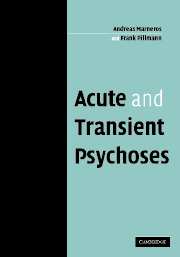Book contents
- Frontmatter
- Contents
- Preface
- Acknowledgements
- Part I History and concepts
- Part II Studies and findings
- 3 Studies on brief and acute psychoses
- 4 Frequency and sociobiographic characteristics of acute and transient psychotic disorders (ATPD) and brief psychoses (BP)
- 5 The clinical features of the acute episode
- 6 Treatment
- 7 The longitudinal course
- 8 The long-term outcome
- 9 Suicidal behaviour
- 10 Comorbidity and somatic findings
- Part III Issues of nosology
- References
- Index
3 - Studies on brief and acute psychoses
from Part II - Studies and findings
Published online by Cambridge University Press: 07 August 2009
- Frontmatter
- Contents
- Preface
- Acknowledgements
- Part I History and concepts
- Part II Studies and findings
- 3 Studies on brief and acute psychoses
- 4 Frequency and sociobiographic characteristics of acute and transient psychotic disorders (ATPD) and brief psychoses (BP)
- 5 The clinical features of the acute episode
- 6 Treatment
- 7 The longitudinal course
- 8 The long-term outcome
- 9 Suicidal behaviour
- 10 Comorbidity and somatic findings
- Part III Issues of nosology
- References
- Index
Summary
This chapter describes the few studies that have investigated samples of patients with ATPD according to ICD-10 or BP according to DSM-IV only. The characteristics of the patients' samples, the methods of the studies and the principal results are mentioned here. More detailed results and their discussions, however, are reported in the appropriate sections of Chapters 4 to 10. A particular emphasis is on the Halle Study on Brief and Acute Psychoses, the most extensive study so far. At the beginning of this chapter, we also consider a number of studies using modified criteria. These studies have addressed the problem of Acute Brief Psychoses explicitly, and they provide data that have bearing on current and future operational criteria of ATPD and BP. Most of these investigations are based on international studies conducted by the WHO, some of which have already been mentioned on page 37ff. In accordance with the high prevalence of Acute Brief Psychoses in developing countries, much of the relevant data have been collected from there. India, in particular, is a country where a good deal of research on Acute Brief Psychoses has been done.
Studies using modified criteria of Brief and Acute Psychoses
As we have seen above, ICD-10 and DSM-IV have given different sets of diagnostic criteria for Brief and Acute Psychoses. A number of studies, some of which were designed and conducted before publication of ICD-10 and DSM-IV, have used their own operational criteria differing both from ICD-10 and DSM-IV. These ‘modified’ criteria deviate from the ICD-10 and DSM-IV criteria, mainly in terms of duration, and some of them also demand a certain pattern of course.
- Type
- Chapter
- Information
- Acute and Transient Psychoses , pp. 43 - 70Publisher: Cambridge University PressPrint publication year: 2004



